Johann Jacob Wannemacher
arrived in Georgia and not Pennsylvania !!!
Jacob Wannemacher (bap. 18 Aug 1715 Waldmohr, Germany – d. 1768 SC) did not arrive in Philadelphia, Pennsylvania, as many of us have believed for so many decades. Instead, Jacob Wannemacher arrived in Georgia. This fact was brought to my attention by Joel H. Hutto who has conducted a tremendous amount of research on quite a few of the Orangeburgh Township settlers. His research efforts have afforded him the opportunity to travel to Germany several times and review many records in person. He has also researched many of these settlers who emigrated from the Basel-Landschaft, Bern, Graubünden, and Zürich Cantons. What an extraordinary job to have, and I look forward to reading his book when it is published. I’m certain that Joel and his collaborators, Harriet Imrey, and Margaret Waters, will provide much more detail about this development in the future, but they have graciously allowed me to share this news about Jacob on the Wannamaker Genealogy website.
As a brief side note, while Joel was researching in Waldmohr in 2017, he, too, had come across Jacob’s baptismal record. However, without proper documentation for Jacob’s parents and his birthplace, it was difficult for him to know if “this” Jacob was the “right” Jacob. This is the same problem I had in the early 2000’s when I hired a genealogist in Germany to search for me. I was sent a list of many possible candidates for Jacob Wannemacher all of whom had the first names “Johann Jacob” or some variation of the two. It really seemed that finding “my” Jacob would forever be a futile goal…until many years later. To this day, I am still very grateful for advances in DNA testing, especially Y-DNA testing, and for the increased availability of online genealogical records. Utilizing both helped to identify Jacob’s parents and his birthplace in 2018.
If you recall, elsewhere on this site, I mentioned that there was doubt about Jacob landing in Philadelphia, Pennsylvania, on the ship Charming Nancy on November 9, 1738. Members of my family and others around town wondered why there was absolutely no mention in genealogical resources of his travels between Pennsylvania and South Carolina. Well, now we know why! And, not only did Jacob arrive in Georgia on the ship Three Sisters in 1737, he came to this country as an indentured servant. There is a record or reference to the fact that he was indentured to Jacob Hamm. Since indentured servitude was common at the time, that should not be a surprise. I believe even Scottowe Wannamaker mentioned this as a strong possibility for Jacob. But, now we have proof from Joel Hutto and Harriet Imrey. And, thanks to these two genealogists, we now have proof that Jacob travelled from Georgia to Orangeburgh Township. And, there is more….
There is also more information to support the notion that Jacob Wannemacher’s first wife was Catherina FRITZ and not Miss Schuler. I first saw this detail on Joop Geisendanner’s old website many years ago, but I chose not to follow up on it. Then, last year, my Wannamaker cousin in Germany, Karina Kulbach-Fricke, who is an historical fiction writer, shared the same information with me. I had no time to follow up on it with ongoing renovations, having recently moved into the old Wannamaker family home in Orangeburg, SC. And, this year, Harriet Imrey had the Fritz family in her research notes which she shared with me. So, this time, I thought I better “get up to speed.”
I purchased four books, authored by George Fenwick Jones, which contain much of this information about Jacob and many other German families in colonial Georgia. George Fenwick Jones was a professor emeritus of German and comparative literature at the University of Maryland. He conducted extensive research on the Germans in colonial Georgia, resulting in 23 publications as mentioned in his obituary. Thankfully, Joel H. Hutto and Harriet Imrey have shared with me some of their genealogical discoveries, professional conclusions, and relevant documents from Jones’ books and other resources. In turn, they have allowed me to post some of this information here. It would be quickest and easiest to do so in an outline format, and please know that as more information becomes available there may be more updates on this page. So, check back every so often.
1715 Jacob Wannemacher is born in Waldmohr
FROM JOEL H. HUTTO:
Johann Jacob Wannenmacher was baptized in the Lutheran Church in Waldmohr on 18 Aug 1715, the son of Johann Jacob Wannenmacher, brickmaker here (in Waldmohr) and Maria Magdalena. The father’s brother Johann Jacob Wannenmacher of Bierbach was one of the baptismal sponsors. Though I did not find a burial record for Jacob’s mother, his father remarried twice at the Lutheran Church in Waldmohr.
FROM KARINA KULBACH-FRICKE:
Liebe Cousine Julia,
Mein Vorfahre Johann Jacob Wannemacher, 1690-1764, war also Pate bei seinem Neffen, Ihrem Vorfahren Johann Jacob W., der nach USA emigrierte.
Herzlichen Gruß
Karina Kulbach-Fricke
(Karina is pointing out that her ancestor, Johann Jacob Wannemacher (b. 1690), is the godfather of his nephew who is also my immigrant ancestor, Johann Jacob Wannemacher (b. 1715 Waldmohr).
1718-1720 Jacob’s Father Married Twice More
FROM JOEL H. HUTTO:
Jacob’s (1715) father remarried twice at the Lutheran Church in Waldmohr:
m2nd:
1 Mar 1718 Johann Weingart Wannenmacher, brickmaker, Lutheran, here, widower, to Anna Ursula, daughter of Johann Hamm of Webenheim.
m3rd:
2 Jul 1720 Wingart Wannenmacher, widower and brickmaker, with Anna Catharina, the late Dietrich Zimmerman’s surviving daughter (she is Reformed)
FROM KARINA KULBACH-FRICKE:

1737 The Ship, Three Sisters, Arrives on December 21, 1737
FROM HARRIET IMREY:
Harriet shared the Three Sisters ship list from this source, the Journal of Thomas Causton Esq. 1st Bailif of Savannah 1737. On page 166, we can see that the ship Three Sisters arrived in Georgia on December 21, 1737. Also on this page, we see the name of Conrade Densler, another known ancestor to many in Orangeburgh Township. On pages, 167 and 171, respectively, there are the names of Henry Fritz’s family, including Susanh. Catherine, and Jacob Wannamaker (spelled Vonomaker). I find it interesting that both S. Catherine Fritz and Jacob Wannamaker were transferred out to Mr. Williamson. How does this fit with the notation that Jacob was indentured to Jacob Hamm? I’m confident that both Joel and Harriet will be able to figure this out if they don’t already know the answer to that question.
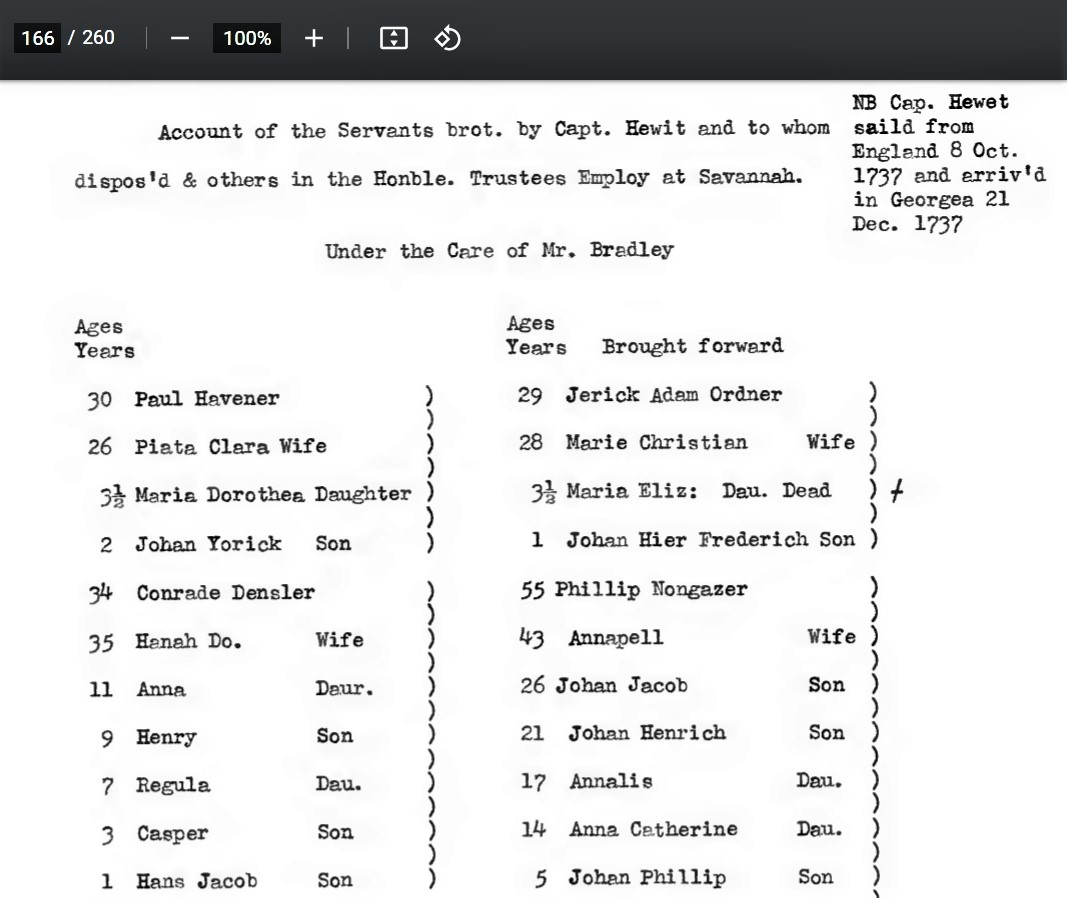
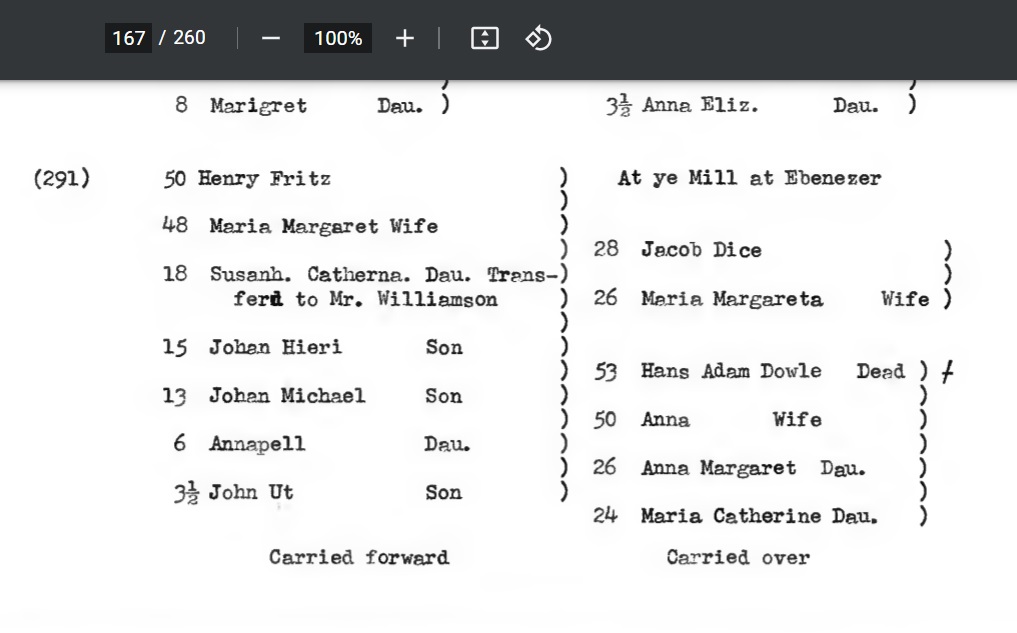
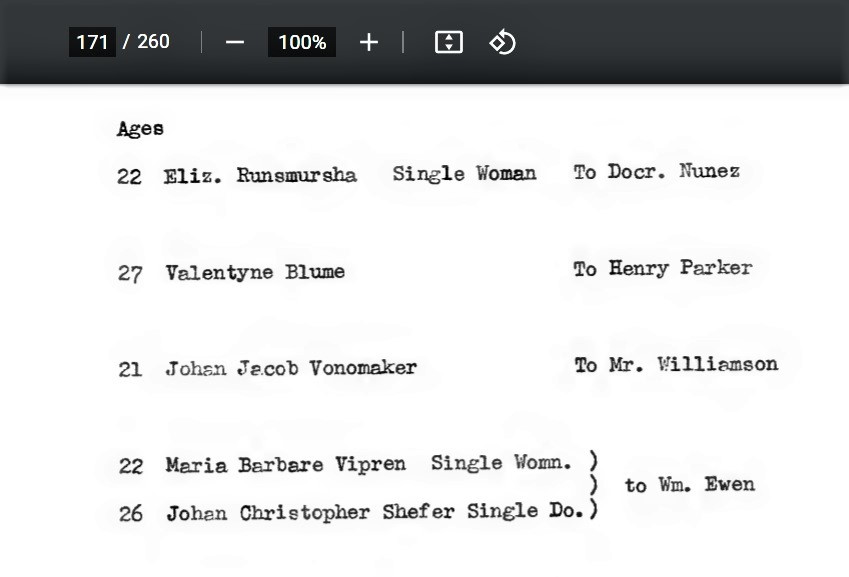
MY NOTE:
One other source for this ship list is from the Palatine Project at Ancestry. You can view it here. There is more detail on this page regarding a specific arrival location, Tybee Island in Georgia. This is exciting and I look forward to learning more about this fact. In any case, it certainly makes sense that Jacob Wannamaker and the Schuler family would have travelled together (as best they could) like so many emigrant families did at the time.
Ship: Three Sisters
Captain: Hewitt
From: Rotterdam
By Way of: Cowes
Arrival: Tybee Island on the Savannah River, 21 Dec 1737
Palatines (Bayern-Pfalz) and Württembergers. This list comes from the Phillips Collection, Egmont Papers, Vol. 14203, P. II, pp.156-164 and was published in the book, “The Salzburger Expulsion Lists” by Lewis Bunker Rohrbach (Rockport, Maine: Picton Press, 1999), pp.608-613.
FROM HARRIET IMREY:
Harriet writes:
Here are the details about Jacob Wannemacher’s (Vanomaker) indenture. He’d been indented to Johann Jacob Hamm while in Rotterdam, but the terms got changed to an indenture to the GA Trustees before the ship left port. The letter was to instruct the Trustees’ representative in Savannah to repay what Hamm had laid out for half his ship fare.
Letters to Georgia, v. 14209, 1737 June-1739 April
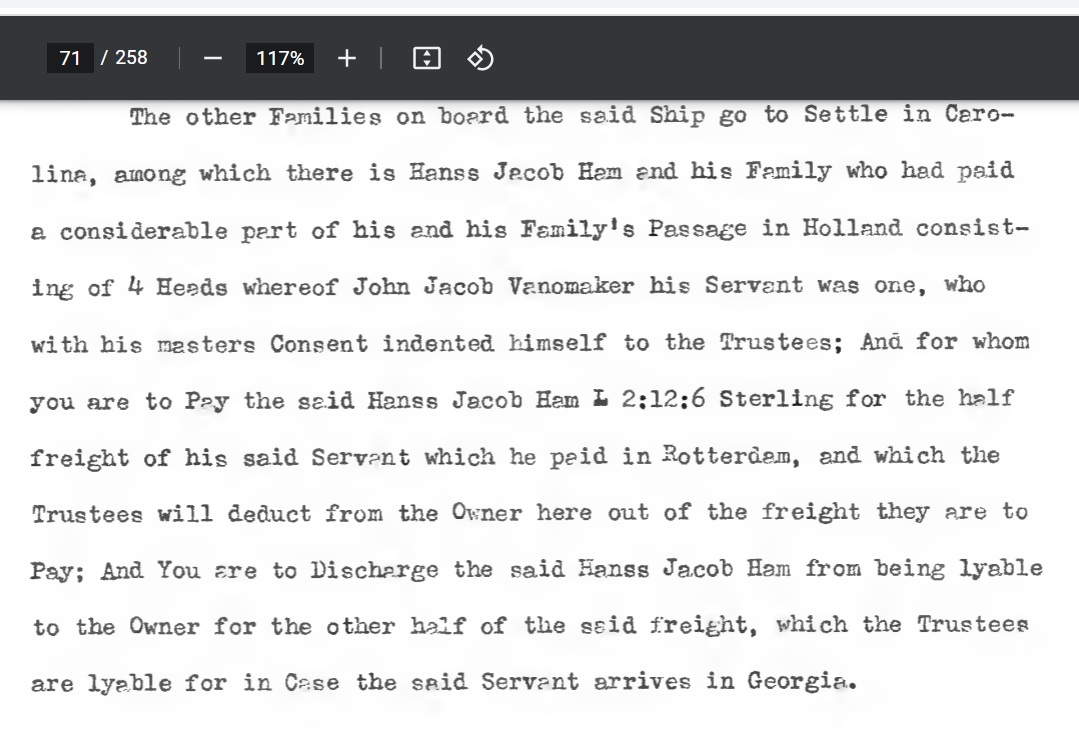
Regarding what our ancestors ate while on the ships, Harriet shares one of her interesting posts from OrangeburghSC@groups.io.
I found a couple of articles describing the food eaten by 18th century immigrants, and one of them managed to identify the ship that brought settlers to Orangeburgh in late 1737. You can locate the first one by a search on <Klaus Wust “Feeding the Palatines”>. The rest of the title is “Shipboard Diet in the Eighteenth Century.” It includes the contractual menus for three Rotterdam shipping firms in the early 1750’s, one for an average merchant (Daniel Harvart), one for a merchant with a very good reputation (John Dick), and one for a high-volume/bad-reputation merchant (Hope Brothers). Not very appealing food, but the weevils, lice and creepy-crawlies provided some extra protein. The second article is more specific to Orangeburgh. It’s Elizabeth Clarke Kieffer, “The Cheese Was Good”, Pennsylvania Folklife, Vol. 19, No. 3 (1970). I found it via a search on <Kieffer “Cheese Was Good”> just this morning.
I’ve been curious about the group of Palatines who left for Orangeburgh in 1737. Those families included Schuler, Jutzi, Schaumlöffel, Götz, Yonn, Bruck, Shower, Fritchman, Ursula San, Morris, Miller, Tschudi and Kirch. Their plats were laid out between December 1738 and July 1739. One lone Swiss (Hans Wetzstein/Whetstone, from Illnau/Zürich) arrived with the Palatines. Whetstone left Zürich in 1737; Jacob Schuler, Georg Schuler and Jacob Bruck were listed as 1737 emigrants from the western Palatinate. Jutzi, Schaumlöffel and Götz have been traced to that time and place. I have seen their ship identified as the Samuel, Capt. Hugh Percy, which cleared Philadelphia for Charlestown in November (Pennsylvania Gazette, 10 Nov 1737). Surviving issues of the SC Gazette do not identify the week of arrival, but it was loading for departure by December (SC Gazette, 1 Dec 1737), and cleared the port for London before Christmas (SC Gazette, 22 Dec 1737). The Orangeburgh Palatines could not have been on the Samuel, because 318 Palatine passengers debarked from it in Philadelphia on 25 Aug 1737. The ship was rated for no more than 300 freights (children aged 4 < 14 were half a freight), so there was no room aboard for the SC group. No ship arrived in Charlestown from Rotterdam between June 1737 and December 1738, so how did they get there?
I found clues in the passenger list for the ship Three Sisters, Capt. Benjamin Hewitt, which arrived in Savannah on 24 Dec 1737. The GA Trustees wanted to purchase up to 150 servants from Palatines recruited in Rotterdam. The (infamous) Hope Brothers had delayed the departure of the vessel until they’d signed up 300 to fill the ship. Thirty of those (well, 29.5) ran away in England due to bad treatment and starvation rations between Rotterdam and Cowes; 120.5 freights were offloaded for service in GA, and the remainder were contracted for Charlestown with merchant Samuel Wragg. They had paid a portion of the ship fare (£6.5 per freight), and hoped to raise the rest from friends in SC. If they could not, they owed indentured servitude to Wragg.
The Zweibrücken Manumission Protocols listed 8 families that left “for Carolina” in 1737, including Jacob Schuler (Georg Schuler said his destination was just “America”). Four other Carolina-bound families, those of Theobald Kieffer and Michel Hart of Kirkel, Adam Diehl of Einöth, and Heinrich Fritz, were named on the list of servants indented for GA. Another name on the Three Sisters list was Conrad Denzler, of Illnau/Zürich. His wife Anna was sister to Hans Wetzstein/Whetstone, whose family joined the Denzlers for the trip. Each couple left with 5 young children. All of the Denzler children survived the voyage, while two of the Whetstones did not. These pieces of evidence suggest that the Orangeburgh settlers of late 1737 were passengers on the ship Three Sisters, Capt. Benjamin Hewitt, arriving in Charlestown from GA the first week of 1738 (SC Gazette, 12 Jan 1737/8). Suggestive, but not conclusive. The conclusive proof is in the Kieffer article cited above (“The Cheese Was Good”). When Theobald Kieffer went from Cowes to London to present the passengers’ petition to the King, three other passengers joined him. The first-listed of those was Valentine Jutzig. Since the Utseys definitely sailed on the Three Sisters, so did their fellow passengers.
FROM JOEL H. HUTTO:
George Fenwick Jones’s book, “The Georgia Dutch,” page 155:
“On 5 November 1737 John Jacob Vanomaker (Wannemacher) arrived as a servant to Hans Jacob Hamm, a German who had just emigrated from the West Indies. Not wishing to leave Savannah, Wannemacher indentured himself to the Trustees, who thereupon ordered Causton to repay his freight to Hamm when the latter proceeded to South Carolina with his large family. Eventually Hamm returned to Georgia. Wannemacher soon moved to Orangeburg County in South Carolina, but recently some of his descendants have returned to Savannah.”
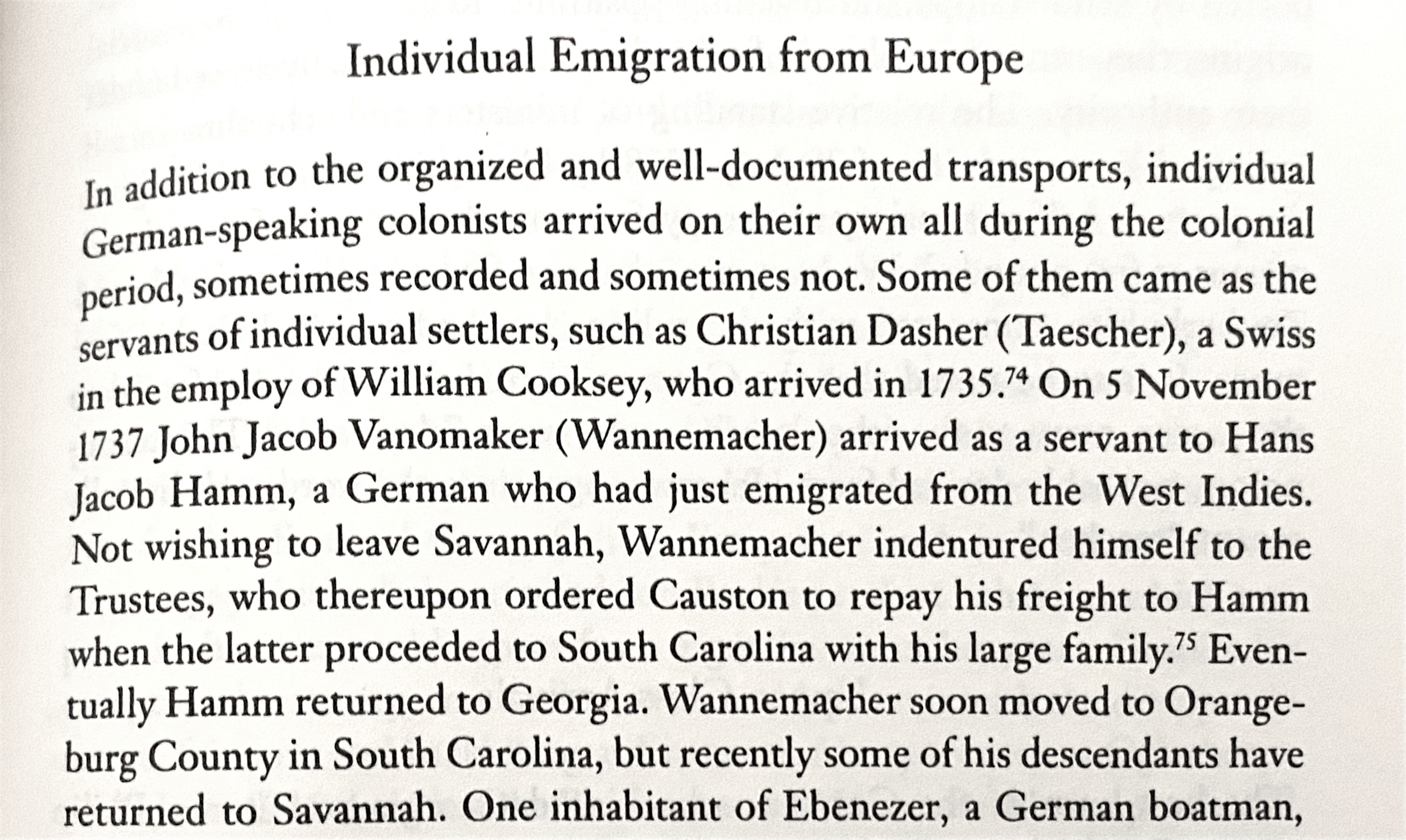
1738-1740 Jacob’s Marriages
FROM JOOP GIESENDANNER’S OLD WEBSITE
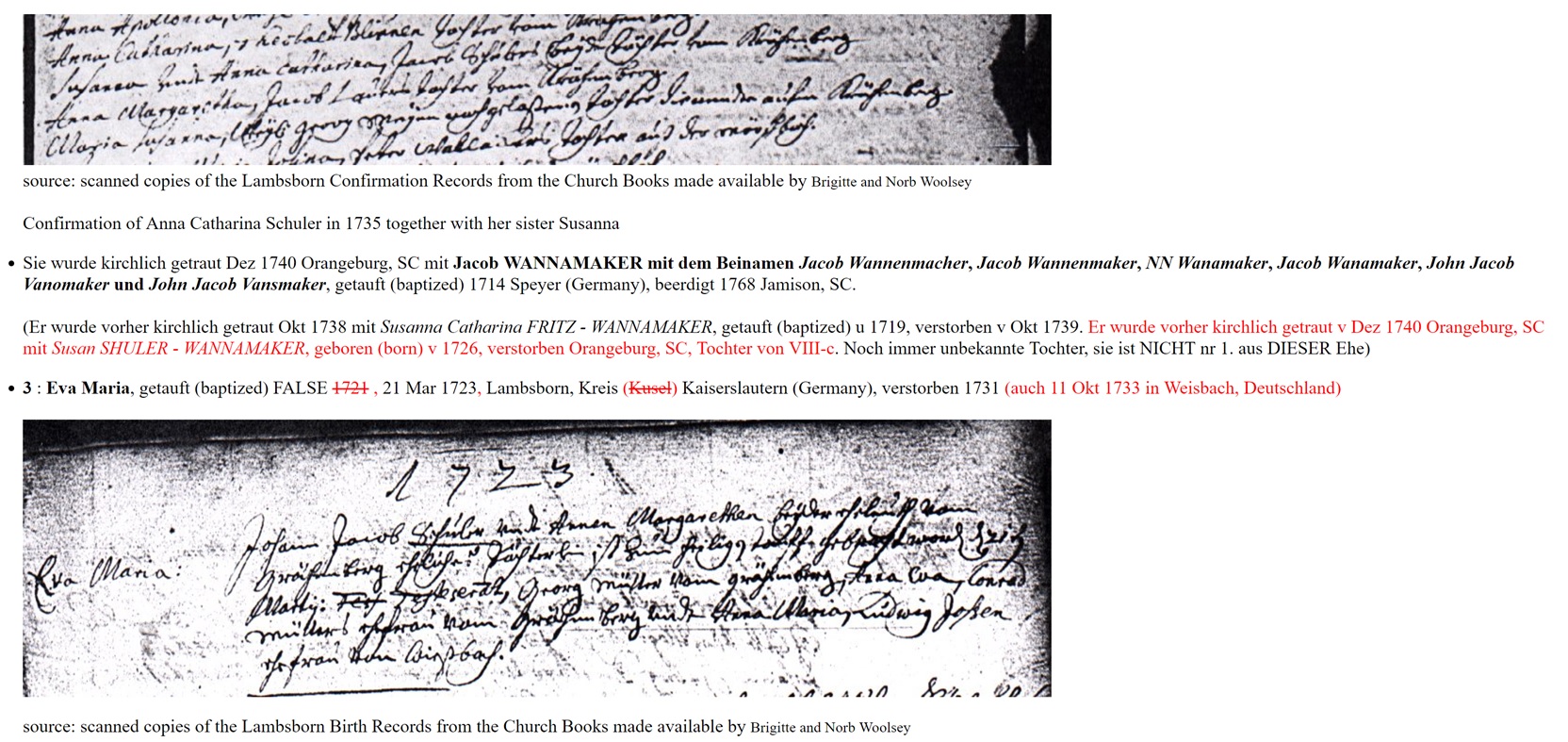
Er wurde vorher kirchlich getraut Okt 1738 mit Susanna Catharina Fritz-Wannamaker, getauft (baptized)
u 1719, verstorben v Okt 1739.
He was previously churchly married Oct 1738 with Susanna Catharina Fritz-Wannamaker, baptized u 1719, died v Oct 1739.
Er wurde vorher kirchlich getraut Okt 1740 Orangeburg, SC, mit Susan Shuler-Wannamaker, geboren (born) v 1726, verstorben Orangeburg, SC, Tochter von VIII-c. Noch immer unbekannte Tochter, sie is NICHT nr 1. aus DIESER Ehe)
He was previously religiously married Oct 1740 Orangeburg, SC, with Susan Shuler-Wannamaker, born v 1726, died Orangeburg, SC, daughter of VIII-c. Still unknown daughter, she is NOT number 1. from THIS marriage)
FROM KARINA KULBACH-FRICKE:
Wannemacher (Wannamaker) Johann Jacob, Farmer
* Waldmohr 18.8.1715
† 1768 in Jamison, South Car., ‡ 1768 in Wannamaker Graveyard, Jamison, S.Car.
oo 1/1 zwischen … und 10.1738 mit Fritz Susanna Catharina, * um 1719, † vor 10.1739 in Orangeburg, S. Car..
oo 2/1 03.12.1740 in Orangeburg, S.Carol. mit Schuler (r) Anna Catharina, ~ 17.10.1720 in Lambsborn, Kaiserslautern, † 03.12.1780 in Orangeburg, S. Car.
1749 Land Petition to Council Journal on Saturday 25 Nov 1749
FROM HARRIET IMREY:
Harriet shared the text of Catherine Wannamaker’s Land Petition. Luckily, the new Orangeburg County Library opened a couple of weeks ago. So, I was able to find this series of land petitions. Catherine’s petition is found on page 97 of “Petitions for Land From The South Carolina Council Journals,” vol II:1748-1752, by Brent H. Holcomb. 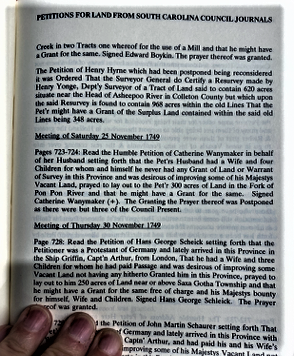
Harriet’s comments:
So he got delayed for lack of a quorum…
If they waited for the law to change in 1751, he’d have been eligible for a Bounty grant. I don’t know what happened next. And, I don’t know why he sent Catherine to Charlestown in 1749, rather than going himself.
The other GA servants (nearly all from Germany, mainly Zweibrücken) completed their indentures in 1741 and were granted land in GA, then in the villages of Acton and Hampstead. Wannamaker had departed much earlier given his 1740 marriage in Orangeburgh. Some of the GA servants who left there somewhat informally were reported to have gone to Saxegotha Township or Orangeburgh Township, and SC authorities were advised to be on the lookout for the runaway servants. The local people were not especially helpful in rounding those up, but nobody knew how the British clerks in Charlestown would react. The dates on this might help explain why wife Catherine was sent to Charlestown in 1749 to present the family’s petition for land with no mention of her husband’s name. Given the absence of a quorum on the SC Council, no action was taken on her petition. Jacob Wannamaker waited a very long time to return with a land petition for himself.
2021 Questions and Comments
As more records are found and Wannamaker researchers try to resolve some facts that seem to be contradictory, I will continue to post tidbits when possible. This is certainly not all there is to say on the subject matter. I just couldn’t post everything included in all the wonderful emails, files, and documents which I have received in recent months.
And, there is definitely more to discover. You may be wondering why this information was not well known long ago. Well, as George Fenwick Jones wrote in the Preface of his “Georgia Dutch” book, “…the Germans of Georgia have received very little scholarly attention, mainly because the chief sources are locked away in German manuscripts not readily accessible to most Georgia historians. Also, the colonial records of Georgia were written mainly by men totally ignorant of the language and history of Germany, who normally anglicized German names, often beyond recognition.”
With the help of Joel, Harriet, and Margaret, I believe we will learn much more about our German ancestors in the coming years. Hopefully, they will allow me to share some of this information or we can patiently wait until the book comes out. It should be a fascinating read!
Julia Wannamaker
JuliaWannamaker@gmail.com
posted November 21, 2021